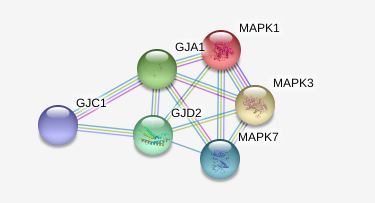Introduction of GJD2
Gap junction delta-2 protein (GJD2) is also known as gap junction alpha-9 protein (GJA9) or connexin-36 (Cx36). It is encoded by the GJD2 gene, which is a member of the connexin gene family. Connexins are gap junction proteins which are expressed predominantly in mammalian neurons. They are arranged in groups of 6 around a central pore to form a connexon which is a component of the gap junction intercellular channel. The channels formed by connexins protein allow for the cationic molecule exchange between human beta cells, thus playing a role in the regulation of insulin secretion. Connexins associate in groups of 6 and are organized radially around a central pore to form connexons. Each gap junction intercellular channel is formed by the conjunction of 2 connexons.
| Basic Information of GJD2 | |
| Protein Name | Gap junction delta-2 protein |
| Gene Name | GJD2 |
| Aliases | Connexin-36, Cx36, Gap junction alpha-9 protein, GJA9 |
| Organism | Homo sapiens (Human) |
| UniProt ID | Q9UKL4 |
| Transmembrane Times | 4 |
| Length (aa) | 321 |
| Sequence | MGEWTILERLLEAAVQQHSTMIGRILLTVVVIFRILIVAIVGETVYDDEQTMFVCNTLQPGCNQACYDRAFPISHIRYWVFQIIMVCTPSLCFITYSVHQSAKQRERRYSTVFLALDRDPPESIGGPGGTGGGGSGGGKREDKKLQNAIVNGVLQNTENTSKETEPDCLEVKELTPHPSGLRTASKSKLRRQEGISRFYIIQVVFRNALEIGFLVGQYFLYGFSVPGLYECNRYPCIKEVECYVSRPTEKTVFLVFMFAVSGICVVLNLAELNHLGWRKIKLAVRGAQAKRKSIYEIRNKDLPRVSVPNFGRTQSSDSAYV |
Function of GJD2 Membrane Protein
Gene Ontology (GO) annotations related to this gene include gap junction channel activity. Diseases associated with GJD2 include refractive error and degenerative myopia. Among its related pathways are transmission across electrical synapses and gap junction trafficking. The presence of gap junctions (GJs) between sympathetic preganglionic neurones (SPNs) influences their activity because electronic coupling allows transfer of electrical signals rapidly and securely between coupled cells. GJs in SPNs include the connexin 36 (Cx36) protein because Cx36 immunoreactivity has been detected between SPNs. It shows that deletion of Cx36 causes dysregulation of sympathetic outflow, cardiovascular variables, and their reflex control. This dysregulation is associated with disruption of normal GJ coupling in SPNs.
 Fig.1 Interacting proteins for GJD2 gene.
Fig.1 Interacting proteins for GJD2 gene.
Application of GJD2 Membrane Protein in Literature
The study demonstrates that the nicotine protects rat hypoglossal motoneurons (HM) from excitotoxic death by downregulation of connexin 36. This suggests that retarding or inhibiting HM death can be experimentally achieved by targeting one of these processes resulting in motoneuron death.
The article indicates that even though Cx36 may be required for electrical coupling of SCN cells, it does not affect coupling of molecular clock gene rhythms.
The article shows that connexin 36-containing gap junctions are involved in the physiologic regulation of heart rate and blood pressure.
The article reveals the critical position of Cx36 phosphorylation in the control of photoreceptor coupling. The data shows that Cx36 phosphorylation is higher under dark-adapted conditions at night than in the daytime and is the lowest under prolonged illumination at any time of the day/night cycle.
This article reports that the detected decreased in the neuronal proteins level is accompanied by the impaired coexpression of synaptophysin / neurofilaments and Cx36 in human brain astrocytic tumors of different grades.
GJD2 Preparation Options
To obtain the soluble and functional target protein, the versatile Magic™ membrane protein production platform in Creative Biolabs enables many flexible options, from which you can always find a better match for your particular project. Besides, aided by our versatile Magic™ anti-membrane protein antibody discovery platform, we also provide customized anti-GJD2 antibody development services.
As a leading service provider, Creative Biolabs is proud to present our professional service in membrane protein preparation and helps you with the research of membrane proteins. Please do not hesitate to inquire us for more details.
All listed services and products are For Research Use Only. Do Not use in any diagnostic or therapeutic applications.